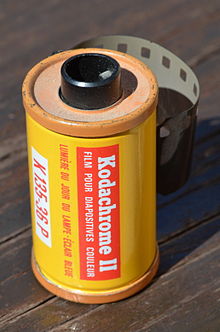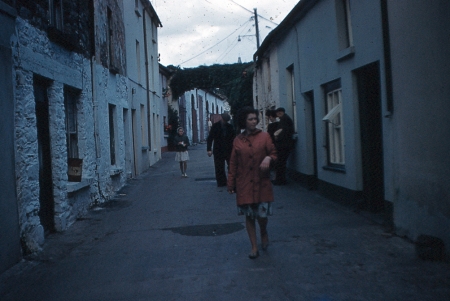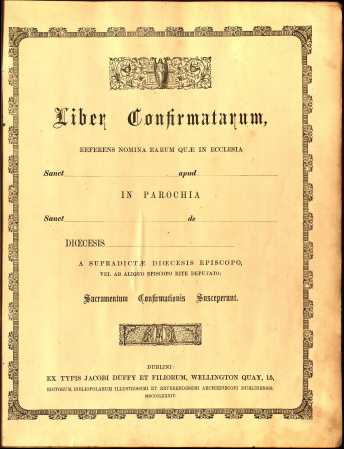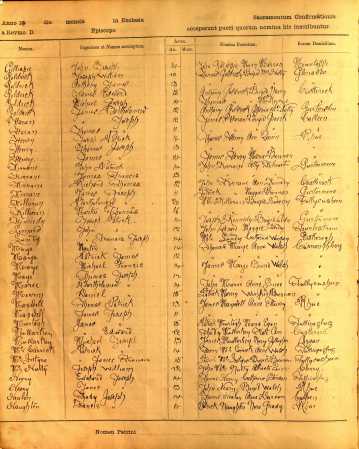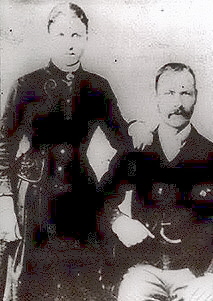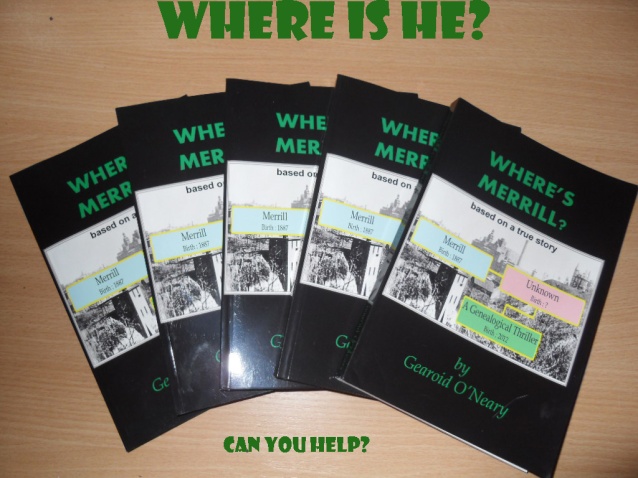Here’s a tale that resonates with my own research into the origins of an elusive O’Connor from “somewhere in Ireland” told here: Johanna
Never give up. You just never know ….
[courtesy of Mary O’Connor Tossell and Irish Central]
“The O’Connor family bible came into my possession after the death of my grandparents. I noticed within it, a few pages with lists of family birth, death and marriage information dating back to the mid 1800s that I’d never seen before. Not long after, I received a 1924 newspaper article celebrating my great grandparent’s 50th wedding anniversary from a second cousin, with lots of family details that were new to me. I realized there was a lot I didn’t know and, ironically, those that could help with any questions were no longer here to answer them. I will forever berate myself as to why I hadn’t thought to I ask them when they were still alive.
In the spring of 1997, armed with this additional information, I hoped an answer to a seemingly unanswerable question might now be within reach. I was inspired to embark on a grand journey, to find the answer to my quest.
Where in Ireland did my O’Connor family come from?
I didn’t have a clue as to a townland nor even a county. I really only knew the names of my great grandparents, and that one of my ancestors was born in Ireland. (I wasn’t even sure which generation!) I thought the next step should be to try to find out who was buried in our O’Connor cemetery plot back where my grandparents came from in Vermont, hoping that might lead to a birth place in Ireland written on a tombstone or a burial record. If not, I thought at least it would help to locate their vital records once I determined exact dates.
While inquiring by phone long distance at the family cemetery, a very kind person going the extra mile at the rectory in Brattleboro, Vermont said:
“Wait, there’s another plot of O’Connors”.
“What?!”
To my great surprise as it turns out, she revealed the names of my previously unknown to me, great great grandparents. I never even knew they were buried there. If she hadn’t bothered, I may never have known! No mention though, of a birthplace other than merely “Ireland” and alas, no indication either on the tombstones themselves.
So, my emigrant ancestors were Maurice O’Connor and his wife Catherine Martin, both born 1822 according to the gravemarker. It was they, I later came to find out, who made the trek across the Atlantic during the worst part of the so called Irish Potato Famine; 1847, aka Black ’47, the year of the “coffin ships” into Quebec….or maybe I should say the starvation! Oh, but don’t get me started on that one, that is for another time to tell.
Next step was to try to locate Maurice’s death listing from the Brattleboro town clerk’s office to obtain the month and day and maybe a birthplace, as I now had a year of death from the cemetery information. I was merely calling to find out how to go about getting a death certificate if you only had a year i.e. 1898, when the clerk asked me to wait while she checked. She had gone to a dusty shelf and pulled out the ledger for 1898! Would you believe it, she actually went through it month by month to finally find Maurice’s death listed in October of that year, on the 20th – evidence of yet another kindness that advanced my quest that much forward.
But wait, that wasn’t all. As she went across the line of information she read aloud, and came to this:
Parents: Hugh and Johanna O’Connor
Wow! The names of my great great great grandparents. As I was only looking for dates, that was a pretty exciting, unexpected find in itself! Ah yet again, it only said “Ireland” as a birthplace. At least I now had an exact death date. Maybe I could find an obituary that might mention a townland.
By the end of 1997, I was getting rather depressed. I had already tried searching the Brattleboro church and cemetery records, tombstone markings, birth, death, marriage certificates, funeral parlor papers, Vermont Federal Census films, town directories, Vermont genealogy societies, U.S. naturalization papers, passenger lists, civil war veterans & Irish railroad worker references, and the local Family History Center (the Mormons). If I was lucky at all; they said merely “Ireland” as a birthplace. The naturalization papers I obtained from the National Archives in Waltham, Ma. had “Great Britain” even. But no townland mentioned, ever.
I had run out of ideas on how to find a townland in Ireland for my emigrant ancestors… after all this searching I still had no clue where my O’Connor family came from in Ireland. It was beginning to dawn on me that there was a possibility I might never find the answer to my quest.
It started to haunt me, “Would I ever know?” It was at this point that I remember thinking aloud to myself…
“Come on Maurice and Catherine, give me a hand here!”
It was only a few days later that I received an envelope in the mail from the Brooks Library, Brattleboro, Vt. I had all but forgotten having written, months earlier, requesting a search in their microfiche for an obituary in the local 1890s era newspaper. When I hadn’t heard from them, I figured they didn’t come up with anything. But now I had this envelope, I’ll never forget, it was on Jan 3rd 1998…
I realized immediately the significance of the information this envelope may contain. I paused before opening it while I weighed this thought in my mind… Either it had, or it did not have my great great grandfather’s obituary in it. I knew full well this might be my last good chance to find out the place in Ireland where my O’Connors were from … and if not there… Well, I can honestly say I was almost afraid to find out what was inside.
My hands were shaking as I opened the envelope to see what lay there in…
I gasped, as it was a photo copy of a newspaper page. Could it be… an obituary? I could barely take in a breath as I read:
THE VERMONT PHOENIX
Obituary
“Maurice O’Connor…died Oct 20, 1898…he was born in 1823, at Mt. Brendon, Co Clare, Ireland”
Oh my Gosh! There it was! My eyes filled with tears as I realized after all this searching, at last, in black and white;
THE TOWNLAND!
My excitement was short lived…I was anxious to see exactly where Mt Brendon was, so I got on the internet to look for maps of County Clare. I found some good maps. But after much of what turned into frantic searching, I sadly realized, there is no such townland called Mt Brendon then or now in County Clare!
Now what? I was very discouraged.
Well I kept digging. I did find a village called Brandon, in County Kerry, on the eastern slopes of a mountain called Brandon… could this be it? … and would that mean I’d have to conclude my ancestor did not know what county he was from!? By this time I was really starting to doubt the usefulness of my newly discovered “find”.
Actually the more I thought about it, maybe County Kerry was the place to search… after all, it did have a Mt Brandon! In the meantime, I saw another site on the internet about tourism in Ireland and County Kerry where the village of Brandon was on the Dingle Peninsula; and was looking at prices of Bed and Breakfast places etc. … mistily dreaming about a someday trip to the Mt Brandon area; in the event that it might prove to be the right place….
When low and behold, begosh and begorrah, I spotted an email address for The Stone Cottage B&B in a town called Dingle whose proprietors at the time were named Becky and Michael O’Connor. What the heck, on an impulse, knowing full well it may be for naught, I emailed them.
I received an email back from them the next day. They were not my O’Connors (yeah, I knew I was just stabbing in the dark!)… but Becky did say there were O’Connors in the area of the village of Brandon, and that I should visit the O’Connors Pub and Guesthouse in Cloghane (pronounced Cla HANE) near to Brandon sometime and ask them. As I wasn’t planning a trip to Ireland any time soon, I instead wrote to the O’Connor Pub and Guesthouse that was mentioned and sent what family history I was aware of … and then promptly put it out of my mind. No use getting my hopes up. Still, wasn’t it nice of her to suggest though?
About a week later I got a phone call …from Ireland! It was the proprietor of the guesthouse, Sean O’Dowd! Although not an O’Connor- his wife was, for which I congratulated him on (haha!). But alas, his wife’s O’Connors also were not related to me either. (Of course, what was I thinking?) Searching for O’Connors in Ireland is like looking for Smiths or Jones in the U.S. (BTW I have discovered O’Connor is one of the oldest of Irish Gaelic surnames, and has a great and glorious history!)
Mr. O’Dowd gave me some hope though about the discrepancy regarding Mt Brandon being referred to as being in County Clare but actually being located in County Kerry . He suggested that if my ancestor, being an Irish Gaelic speaker (Dingle is a Gaeltacht {Irish speaking} area to this day), that the pronunciation of “Mt Brandon, Co Kerry” in the Irish, might sound like “Mt Brendan, Co Clare” to the untrained ear… and as Maurice, my ancestor, did not read or write (surely a result of the Penal Laws against Catholics. Oops, there I go getting off on a tangent again!) he would not have even recognized such an error himself.
 Oh and then there was this; Mr O’Dowd also said he would talk to some other O’Connors that he knew for me, who lived on “the other side of the mountain” from the O’Connor guesthouse in Cloghane. (Mr O’Dowd lived on the eastern side). I thought it was really nice of him, but wasn’t expecting much, … after all, there are 30 thousand O’Connors in County Kerry! Considering after all, we weren’t even related, wasn’t it nice of Mr. O’Dowd to bother!?
Oh and then there was this; Mr O’Dowd also said he would talk to some other O’Connors that he knew for me, who lived on “the other side of the mountain” from the O’Connor guesthouse in Cloghane. (Mr O’Dowd lived on the eastern side). I thought it was really nice of him, but wasn’t expecting much, … after all, there are 30 thousand O’Connors in County Kerry! Considering after all, we weren’t even related, wasn’t it nice of Mr. O’Dowd to bother!?
(For O’Connor researchers; This particular sept of O’Connors {there are 6 separate clans}, calls itself O’Connor-Kerry. Contemporary descendants of this sept are by far the most numerous, and those from Dingle are called the Dingle O’Connor Branch of the O’Connor-Kerry.)
Now get this…The very next day, Jan 22, 1998, I was coming into the house carrying groceries when I heard this curious voice leaving a message on the answering machine…. It sounded Irish! I dropped what I was doing and quickly picked up the phone. It was a man who introduced himself as ‘Himself’* O’Connor of Bally – – -, Dingle, County Kerry, Ireland. (on the western side of Mt Brandon.)
*’Himself’ of course gave me his name but because so many genies have contacted him asking for help I’ve had to remove his name and location for his own sake (and mine!)
‘Himself’ told me he read my information given to him by his dear friend Sean O’Dowd of O’Connor’s Guesthouse and wanted me to know that his great great great grandparents were also called Hugh and Johanna O’Connor. The same names as my great great great grandparents… and they too had a son Maurice who emigrated to America …the same name as my emigrant ancestor! ‘Himself’ descended from a son John of theirs and as it turns out, I might be descended from John’s brother Maurice!
He gave me a marriage date for Hugh and Johanna in 1810; and a birth date in 1821 for Maurice (which fit with what I had… which was a range of 1820-1823 from varying answers in the Vermont Fed Census films, and his gravestone, and the obituary).
He also gave me the names of his Maurice’s siblings, with many familiar given names that I also have in my family; but then again, what Irish family did not have a John, James, Catherine and a Mary back then ?! (BTW I read that 29% of all the women in Ireland were named Mary in the 1850’s!) He also gave a possible explanation for the non existent Mount Brandon townland given as a birthplace …
Its because Maurice O’Connor was born on a cliff in the foothills of Mt Brandon! He left County Kerry because the farm his father had purchased for him had a landslide in 1847 the same year my Maurice emigrated. He said he had a lot more information for me, that he would write it all out. If this really was my Maurice, Wow…. what a find!! I could hardly believe it. I was so excited hearing all this, my hands were shaking trying to write it all down. I could barely read my handwriting afterward and I almost forgot about my quickly defrosting groceries!
There was only one flaw in it all…
When I was young, I remember asking the question; “Why of all places, did our family end up in Brattleboro, Vt ?” The answer was: “That’s where the work on the railroad ended.” …also family history had it that; “The brothers moved on to Chicago to look for work there”. But ‘Himself’ said his Maurice was the only one in the family of that generation to have emigrated, his brothers had not. Hmmm…. as my family was so vague about our roots I wasn’t even sure which generation worked on the railroad … was it my great grandfather John or my great great grandfather Maurice? The real question was, could ‘Himself”s Maurice really be MY Maurice? I needed to do a bit more research to prove the connection… but I must admit, my instincts told me this was probably my family.
There was something strangely eerie about it all, something I didn’t pick up on ’till later, when I was replaying the answering machine message for my husband that ‘Himself’ had started to leave before I picked up.
… it was that ‘Himself’ sounded so very much like my dad ! It was just as if it was my dad talking with a brogue! It was uncanny! It also made me feel like I really had spoken with the Irish descendants of my ancestors from “across the pond”!
To top it all off, ‘Himself’ owns “Tigh ‘Himself'” in Bally – – – Co Kerry. That’s Irish Gaelic for ‘Himself”s Place… a PUB!! What better spot to have a pint and toast your mutual Irish ancestors than Tigh ‘Himself’!? Is that the Luck of the Irish or what?
Please read on, the story doesn’t end here…it gets better!
I thought I would share another tidbit with you about my O’Connor genealogy research, I think its kind of romantic… also some of the info may be helpful to other researchers.
GET THIS! Back in the mid 1800’s to the early 1900’s, the Irish from all over the states posted notices in the “Boston Pilot” newspaper, in search of missing friends and loved ones. This was “the” place to put such a notice. The 6th vol. in a series of 8 books is recently out, covering up to the U.S. civil war period which has gathered all these notices in $45 a piece volumes… quite a hefty price for only one volume even… so not expecting anything, but wanting to rule out a major source of info, and to take advantage of a very kind offer… look what I found when someone on the internet was generous enough to offer to do lookups in her volume, the first of the series:
“The Search for Missing Friends: Irish Immigrant Advertisements Placed in the Boston Pilot” (Volume 1 1831-1850. page 236, 13 November 1847, Information Wanted
OF CATHERINE O’CONNOR, wife of Morris O’Connor, daughter to James Martin of Graan, near Dingle, co Kerry, who emigrated to Quebec last summer, with her brothers, John and James Martin, and is supposed to be in Upper Canada. Any information respecting her will be thankfully received by her husband, who is separated from her by the adversities of fortune. Address, Morris O’Connor, care of James O’Connor, Cabotville, Mass.
WOW! Turns out Graan is a phonetic pronunciation of Garrane, Co Kerry, its in the adjoining parish of Kilmalkedar, next to where Maurice was born, in Kilquane Parish which ‘Himself’ O’Connor told me about when I last reported to you. If this is the right Morris and Catherine, which I think it is, that ad was placed by my great great grandfather! Prior to this I didn’t know if they were married in the U.S. or Ireland (looks like Ireland), I didn’t know Catherine Martin’s father or brothers names!, nor when they emigrated nor where they were from in Ireland!
This could be an answer regarding the “brothers going on to Chicago”, and ‘Himself”s Maurice’s siblings not having emigrated at all… it may have been **Catherine’s Brothers** who moved on to Chicago! That’s IF its a match of course. I’ve also read that the Irish back then used the terms brother and brother-in-law interchangeably. Now I just needed proof…. something to make the connection between my U.S. O’Connor/Martin info and ‘Himself”s O’Connors in Ireland.
Note: Neither Catherine nor Morris could read or write, can you imagine how desperate they must have been, and how helpless they were to try to find each other when they didn’t even speak English in this new and vast country?… countries I should say; America and French speaking Canada !
Epilogue – When I sent the “Missing Persons” ad information to ‘Himself’ O’Connor, he talked the very reluctant local priest in Ballyferriter Roman Catholic parish near Dingle (which contained Kilquane and Kilmalkedar civil parishes) into letting him look at the actual parish records, in Latin! – which by the way, haven’t been filmed by the LDS (the Mormons) like most of the rest of Ireland and the world really….and guess what…
‘Himself’ looked up the marriage record for his Maurice O’Connor; married Shrove Tuesday, Feb. 22, 1846 and spouse; Catherine Martin (parents James Martin and Catherine Moriarty)!… and the whole Martin family births, marriages, just like the ad, in Garrane!!!
IT WAS THEM!
This confirms the Dingle connection to my Maurice from Brattleboro Vt, and my newly discovered 3rd cousin ‘Himself’ O’Connor and family in Bally – – -, Dingle, Co Kerry! I was so excited! And when I said that to ‘Himself’ he said;
“Oh, don’t be excited, it’s just us.”
Ever since I started my research over a year ago I’ve had this idea; that someday, if I ever found where Maurice was born, that I’d bring a bit of dirt from Maurice’s gravesite in Vermont with me for a future visit to Ireland. So how about this… ‘Himself’ told me that the very same land that Maurice was born on, near Mt Brandon (the real townland name by the way, is Clash) is still in the O’Connor family to this day!! Between his Irish brogue and his unique (to me) vocabulary; I wasn’t sure and couldn’t quite make out what he said next… I thought he said:
“The house still exists.”
“Still exists! You mean, I might be able to see it?”
Then I thought he said, “Yes, but it’s a cow house now.”
(Cow house?)
“‘Himself’, What do you mean by; ‘it’s a cow house now’?”
(obviously, a city girl <G>) …after a long pause he said, “Mary…. its where we keep the cows. Now what did you think it was, girl?”
So much for my romantic notions of bringing back a bit of Vermont to Mt Brandon! On second thought, I think maybe Hugh and Johanna’s gravesite would be appropriate don’t ya think? and by the way… Catherine and Maurice must have gotten together after that ad was placed in Nov. 1847 sometime by the next summer; around August of 1848; because my great grandfather John James O’Connor, was born June 17, 1849!
I heard again from my 3rd cousin; ‘Himself’ O’Connor in Ireland… (or should I say ‘Himself’Ó Conchúir; he does!) He sent me a letter; with family group sheets included (with notes in Irish Gaelic!). After searching parish records in Ballyferriter Roman Catholic parish **confirming** our family connection he told me this, which is really what I wanted to share with you;
“We are sure now, that our Maurice Ó Conchúir, is the same man you are looking for”… and later he finished with:
“We are sure now, you are ours.”
‘Himself’ signed it with: “Le mheas mhór, ‘Himself'” (with great love, in Irish Gaelic) Pretty neat, eh? It gave me goosebumps when I first read it… and it still does.
I hope you’ve enjoyed my story, and that it encourages you to keep trying! Máire Ó Conchúir Tossell aka Waterlilys@aol.com.
Follow: @IrishCentral on Twitter | IrishCentral on Facebook
0.000000
0.000000
















